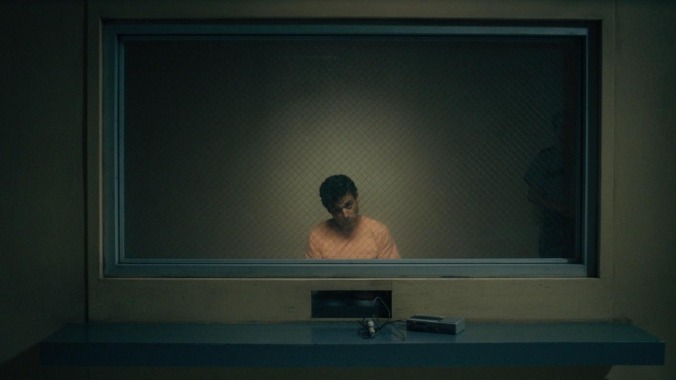No Man Of God inserts Ted Bundy into a Silence Of The Lambs scenario
Interviews with Bundy may have influenced the Thomas Harris classic, but that doesn't make this true-crime drama feel any less redundant

Ted Bundy has always been an irresistible subject for filmmakers. He was in many respects a real-life Norman Bates: good-looking, clean-cut, superficially charming, readily able to pass as an ordinary guy. That’s been true of few known serial killers in history, and the notion that monsters may lurk beneath an inviting façade makes for an especially disturbing contemplation of evil and its nature. But three decades and umpteen mostly made-for-TV movies after Bundy’s execution, are there any fresh insights to be found? It’s been just two years since Zac Efron took on the role, in a film that was notable mostly for declining to depict any of Bundy’s murders, even indirectly. No Man Of God, likewise, eschews almost all sensationalism—it’s set entirely during Bundy’s last few years in prison—and fails to offer much more than the usual portrait of a sociopath who looks frighteningly like the rest of us. What’s more, the one unique angle it does possess was poached by a major author long ago.
That would be Thomas Harris, whose first two Hannibal Lecter novels, Red Dragon and The Silence Of The Lambs, were heavily inspired by work done in the FBI’s Behavioral Science Unit. Just as the latter opens with Clarice Starling assigned to interview Lecter, ostensibly for his psychological profile, No Man Of God kicks off with new Behavioral Science agent Bill Hagmaier (Elijah Wood) volunteering to talk to Bundy (Luke Kirby) for more or less the same purpose. Nobody else wants the job, since Bundy, like Lecter, has rejected all previous FBI requests; if you want to see another warden insist that his prisoner won’t talk, then be astonished when the prisoner agrees to do so, here’s your chance. Bundy, too, initially complains that he was sent a rookie (“trainee” in Starling’s case), but eventually opens up… after Hagmaier agrees to share some personal history of his own. There’s also a recurring “You’re just like me” dynamic to their conversations, which are reportedly based on audio recordings of Hagmaier’s actual sessions with Bundy but now inevitably recall Lecter’s twisted relationship with Red Dragon/Manhunter/Hannibal’s Will Graham.
Is it fair to fault a movie that depicts real-world events for being less compelling than fictional works that were in part inspired by those (or at least similar) events? Maybe not, but it’s also hard to ignore just how familiar No Man Of God feels at virtually every moment. That leaves the film largely in its two lead actors’ hands, and the main reason to see it is to marvel anew at Kirby’s expert mimicry. His Lenny Bruce on The Marvelous Mrs. Maisel captures the comic’s offbeat pugnacious-schlemiel persona to a degree that nobody else (certainly not Dustin Hoffman) has ever managed, even though Kirby looks nothing like Bruce. He does, however, look eerily like Bundy, and he perfectly replicates every vocal and physical mannerism from the lengthy interview that Bundy gave on the day before his execution. The performance is mostly a technical feat—Bundy’s cat-and-mouse game lacks the power to unsettle unless this is your first time watching a serial killer toy with a Fed—but it’s highly impressive all the same. Wood may or may not nail Hagmaier, but the onscreen character is defined by his empathetic professionalism and the crucifix that dangles from his car’s rearview mirror. The big scene in which Bundy describes one of his murders while Hagmaier weeps in horror and shame falls oddly flat.
It’s worth noting that No Man Of God was directed by a woman, Amber Sealey; her previous feature, No Light And No Land Anywhere, was described by New York Times critic Teo Bugbee as “psychologically exposing her male subjects while allowing her female protagonist to remain an enigma.” Women are relatively scarce here—the only one of significance is Bundy’s attorney (Aleksa Palladino). But Sealey, whose formal touch often flirts with cliché (lots of circling around Hagmaier and Bundy, with one man’s face temporarily obscured by the back of the other’s head), pointedly reminds us of Bundy’s many victims, even though none of them are shown. Fearing a Bundy-esque nature buried deep within him, Hagmaier keeps staring at random women who walk or drive past him, temporarily perceiving them as a killer might. And the film’s most striking moment gradually fades the sound on Bundy’s aforementioned final interview (with Christian Clemenson in the role of evangelist James Dobson) as the camera pushes in on an unnamed woman who’s standing there impassively listening to Bundy blame his pathology on porn and detective magazines. She has literally no lines; even her function is unclear, though she seems to be with Dobson. It’s an almost avant-garde flourish, very much welcome in a movie that otherwise treads well-worn ground.